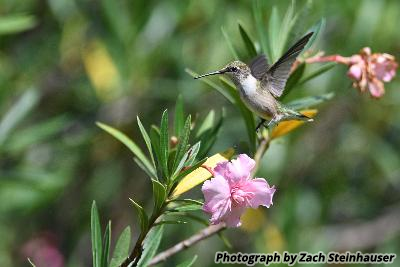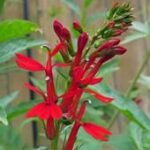 If you haven’t seen them already, it’s definitely time for hummingbirds to appear in South Carolina. Thousands migrate north from Florida, Mexico, Texas, and South America, some tracking as far as Ontario. According to Clemson University, mid-March was the arrival time for the Ruby-Throated Hummingbird, the most prominent species that we see in the Midlands. Watching these beautiful, tiny creatures fly to and from feeders and plants is simply mesmerizing and most certainly a sign that spring has arrived!
If you haven’t seen them already, it’s definitely time for hummingbirds to appear in South Carolina. Thousands migrate north from Florida, Mexico, Texas, and South America, some tracking as far as Ontario. According to Clemson University, mid-March was the arrival time for the Ruby-Throated Hummingbird, the most prominent species that we see in the Midlands. Watching these beautiful, tiny creatures fly to and from feeders and plants is simply mesmerizing and most certainly a sign that spring has arrived!
To witness and enjoy the flight and feeding of hummingbirds, you need only add a feeder or two, and include a few of their favorite flowering plants to provide the nectar that will entice them to visit. Many shapes and sizes of hummingbird feeders are available that provide a functional use and serve as an attractive addition to the garden. Next time you visit Wingard’s, check out our Birding Department located in the Fresh Produce Market.
It’s easy to make your own nectar…simply mix 1 part sugar in 3 parts water. The sugar will dissolve best if the water is hot (be sure to let it cool before you put it in the feeder). Store extra in the refrigerator for up to 7-10 days. No need to add red dye, IN FACT, it may actually harm the little hummers. The nectar will last a bit longer in a part shady/sunny spot. Clean the feeder frequently, at least twice a week, to avoid build-up of mold, especially as the weather gets warmer. Use a vinegar and water solution rather than soap.
It’s a good idea to hang the feeder near a hanging basket or flower pot that contains one of the many plant specimens that attract hummingbirds. Plants that attract hummingbirds typically have brightly-colored, tubular-shaped flowers that make it easy for the tiny birds to feed on nectar. They love red blooms, because the bees don’t, but there are many other bloom colors they will also visit. Once hummingbirds find a reliable food source, they’ll keep coming back for more. Try planting a variety of specimens so that you will have something blooming at different times from spring to fall.
WINGARD’s TOP PICKS TO ATTRACT HUMMINGBIRDS

AGASTACHE/Giant Hyssop/Hummingbird Mint – perennial in the mint family; showy, fragrant, long-blooming with spikes of flowers that bloom most of the summer.

CARDINAL FLOWER/Lobelia – perennial that blooms in late summer to fall; produces cardinal red blooms; great for wet areas. Grows 3-5 feet tall.

COLUMBINE – perennial; unique bell-shaped bloom with spurs in early spring; available in many colors; grows 3-12 inches tall.

CROSSVINE/Bignonia – Vigorous perennial vine that climbs by using tendrils to wrap around stems or bark for support as it grows up tall objects like fences, walls or pine trees. Blooms in late winter to early spring on new wood in clusters of 2-5 flowers. Flower color can range from orange and yellow to reddish-orange.

INDIAN PINK/Pinkroot – SC native perennial with showy, tubular flowers that mature to scarlet red in early summer. Each flower opens with 5-pointed petals that create an intense yellow star. Prefers moist soil; grows in an upright form, 1.5 – 2.5 feet tall.

MANDEVILLA/Rocktrumpet – Annual vine; produces bright colored, trumpet-like blooms and glossy green foliage from spring to fall.

PENSTEMON /Beardtongue – Perennial; many cultivars, with various bloom colors, as well as foliage colors; tall spikes form in spring with colorful tubular flowers. Prefers dry, well-drained soil – will not thrive in moist soil.

PICKERAL WEED – Perennial; great around ponds and lakes; grows in shallow water no more than a foot deep. Shiny green lance-shaped leaves emerge in the spring from below the water and eventually grow to 3-5 feet above the surface. Purple-blue 3 to 4 inch long flower spikes appear several weeks after the foliage, spring to fall.


SALVIA/SAGE – Annual and perennial varieties available; many colors and growth sizes; annuals bloom spring to frost. Here are just a few of the perennial cultivars: Cleveland sage (blue), Pineapple sage (red), Autumn sage (many colors), Mexican Bush sage (deep purple), Purple sage, Salvia microphylla (many pink and red cultivars), and Royal sage (red).
ZINNIA – Annual in the daisy family; assorted colors and bloom sizes available; deadhead spent blooms. Fairly drought tolerant.

